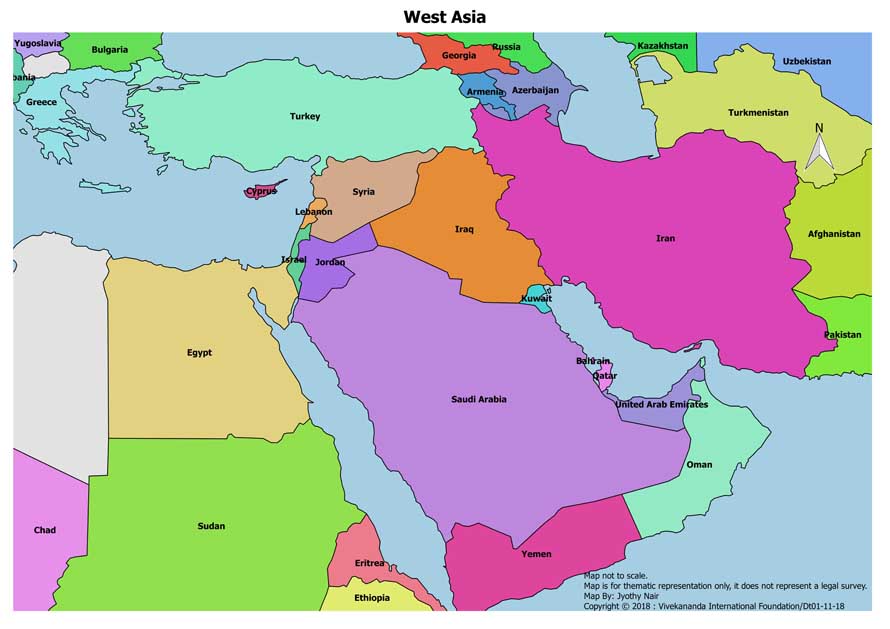Abstract
June was a particularly hot month in so far as the developments in the Middle East are concerned. In the US-Iran imbroglio one witnessed a ‘hot & cold’ approach with the US continuing with its maximum pressure tactics while Iran displayed its hard-line response, even shooting down an armed stealth US drone. Though it could have resulted in a real conflagration but last minute change of mind by President Trump averted the ensuing disaster. Iran also threatened its European partners of its readiness to breach the nuclear threshold if they did not take perceptible action with regard to countering US sanctions.
Europeans and Russians eventually confirmed that their INTEX system of payments – an alternate to SWIFT system - was ready to be launched. Iran, like the proverbial elephant, was in the room be at the Shanghai Cooperation Organisation (SCO) meet in Bishkek, Conference on Intraction and Confidence-Building in Asia (CICA) or the G20 including at the bilateral and trilateral meetings. PM Modi clearly mentioned to Trump at the G20 that even though India had reduced its crude imports to almost zero from Iran, but the worsening situation in the Persian Gulf was of great concern and must be handled with dialogue and foresight. Meanwhile, to protect its shipping lines and to provide some confidence to the 8 million Indians in the Middle East, India placed her naval assets in the Gulf of Oman and Strait of Hormuz.
Trump’s statements varied from “I am not in a hurry” to “Iran will be obliterated”, while his National Security Advisor (NSA) Bolton and State Secretary Pompeo kept on crisscrossing the region to shore up support for their approach, especially from the Gulf states. NSAs of US, Russia and Israel also met in west Jerusalem. Meanwhile, drone attacks and missiles kept on Saudi assets but reportedly several came from pro-Iranian groups in Iraq. This led the Government to put some controls on those groups even if they might be supporting Iranian stance. Japanese PM along with several others tried to mediate to bring Iranians to table but a Japanese flagged ship was hit while PM Abe was still in Tehran. Obviously Iranians denied any hand but conspiracy theory in such situations is a common cause.
Finally, the economic component of the much acclaimed Trump and Kushner plan, “Deal of the Century” to resolve the Palestinian issue was unveiled at the Manama Workshop from June 25-26 to the dissatisfaction of all concerned. While delegations from several countries in the region attended, Palestinians, Iraqis and Lebanon boycotted it completely and the Israeli delegation could not participate as the Bahraini people and parliament opposed ‘stepping Israeli foot on their ground’. Thus the two major supposed beneficiaries were marked by their absence. Also, the statements by Jared Kushner questioning the capability of Palestinians to govern themselves put the final spanner and several Palestinian groups including Hamas had a parallel mini-summit in Beirut. Demonstrations against the Deal in various countries indicates that while their rulers might be ready to take the plunge, the people especially of Palestinian origins are against being short-changed as the distrust for the Americans prevails. As such the Deal was yet to address the core issues that are likely to be announced after the elections in Israel in September which was its biggest drawback. Moreover there was no clarity on the funding of the $50 billion Palestinian Marshal Plan.
In other developments, the continuing civil protests in Sudan took uglier turns with several hundred casualties and public ire rising against the military junta there who are refusing to give up power. On the other han, Algeria witnessed a more matured and understanding approach but civilian groups are maintaining pressure through peaceful demonstrations. Libya continues to be in the throes of civil war with General Haftar’s forces laying seize to Tripoli since April as the efforts to bring about ceasefire are still not being heard by either sides and the European players are indulging in their own narrow interests and supporting sides making it difficult to reduce the violence.
Key Developments
Japanese tankers attacked in the Strait of Hormuz
On 13 June 2019, one Japanese oil tanker named Kokuka Courageous and one Norwegian owned MT Front Altair on bound towards Japan were attacked near the Strait of Hormuz. One of the vessels caught fire and the personnel in both vessels were evacuated by rescue teams provided by the US on board the destroyer USS Bainbridge. The vessels according to the Japanese Trade Ministry were carrying Japan-related cargo. As a consequence of the attack, the price of Benchmark Brent crude hiked by 4 percent resulting in per barrel price at US$ 62. The US jumped on to blame Iran for the attack and on the following day, i.e. 14 June 2019, released a video alleging Iran’s Islamic Revolutionary Guards Corps (IRGC) members removing unexploded limpet mine from one of the vessels. The Japanese company, however, denied use of mines for the attack and witnesses claimed that the ship was attacked by flying objects as major damages had occurred on the ship’s waterline. The President of the Japanese shipping company, Yutaka Kakada claimed that reports of mine attack as false.
The attack on the Japan-bound vessels coincided with the visit of Japanese Prime Minister Shinzo Abe to Iran. The Japanese efforts were aimed at reducing tensions and Abe appealed to Iran to play a more constructive role in building peace and solidarity in the region. Japan has traditionally enjoyed cordial ties with Iran and is suffering from the ramifications of the unilateral US sanctions on the Iranian oil sector. Japan maintained low expectations towards solving the crisis and pushed for a de-escalation between the US and Iran. Iranian Supreme Leader Ayatollah Ali Khamenei assured Japan has it has no intention to develop, own or use any nuclear weapons.
India deployed two ships in the Gulf of Oman
In response to the attack on four oil vessels on 12 May 2019 and 13 June 2019, India has deployed two naval ships, namely Chennai and Sunayna, in the Gulf of Oman and the Persian Gulf to carry out maritime security operations and aerial surveillance. It is aimed at ensuring the security of Indian vessels operating in the highly volatile region.
Iran shot down US drone
On 20 June 2019, Iranian made surface to air missile shot down US’ RQ-4A Global Hawk High-Altitude, Long, Endurance (HALE) Unmanned Aircraft System (UAS). The US has claimed it as an unprovoked act of aggression and argued that the drone was shot down in international waters. The Islamic Republic has claimed the drone was brought down inside Iranian airspace near Kouhemobarak in the southern province of Hormozgan. The drone has a 130 ft wingspan and comparatively slower than combat aircraft. Following the attack, Iran stated that it did not want a confrontation, but crossing the Iranian airspace and maritime space was a red line, and the aforementioned incident displayed its resolve that it was completely and totally ready for war. The head of IRGC’s aerospace division, Amirali Hajizadeh added that the Islamic Republic refrained from attacking a US P-8 plane with 35 people on board that was close to the drone.
The US reportedly intended to retaliate and strike at Iranian radar and missile batteries; in fact, President Donald Trump approved the order, however, it was cancelled. There was reportedly a disagreement over the course of action to be taken in which Secretary of State Mike Pompeo, NSA John R. Bolton and CIA Director Gina Haspel preferred military action. However, Pentagon officials were wary of the consequences of limited military action that could lead to escalation. President Trump tweeted later providing an explanation for the recall. He stated that predicted loss of approximately 150 Iranian lives stopped him for pursuing retaliatory attacks. President Trump, further softening his position, contemplated that a rogue general may have launched the attack on the US drone.
Palestinians reject the ‘Deal of the Century’
On 24 June 2019, the US unveiled the economic vision of the ‘Deal of the Century’ in Manama, Bahrain. The economic vision titled, ‘Peace to Prosperity’ proposal is directed at uplifting the economies of Palestinians and other Arab states and is central to the Middle East Peace Process spearheaded by Jared Kushner. Kushner stated that the plan would create millions of jobs in West Bank and Gaza and hoped that employment would reduce from 30 percent to less than 10 percent and poverty would be greatly reduced. According to the plan, US$ 50 billion would be accumulated from donor states and investors in which US$ 28 billion would be allocated to West Bank and Gaza, US$ 7.5 billion to Jordan, US$ 9 billion to Egypt and US$ 6 billion to Lebanon. Palestinians have rejected the deal as it does not address Palestinian statehood, the status of refugees and Jerusalem. From a Palestinian perspective, the first step to pursue any deal has to start with a political solution based on international law.
Sudan protests
On 30 June 2019, at least seven protestors were killed during pro-democracy mass protests that have been continuing since the ouster of long-time dictator Omar Al-Bashar on 10 April 2019. After the resignation of Al-Bashar, the population was hoping for a return to civilian rule. However, the mass aspirations were cut short by the Army that took over power under the Transitional Military Council. Earlier on 3 June 2019, the military government’s paramilitary unit, Rapid Security Forces (RSF) attacked and killed 118 protestors that were demanding democratic reform. In the latest assault, besides the death of seven protestors, more than 180 people have been injured. The riot police have also utilized tear gas, live ammunition and stun grenades to suppress protests.
Israel-Syria clashes
On 1 June 2019, two rockets were fired near Mt. Hermon in Israeli-occupied Golan Heights. On the same day, an Israeli-aircraft flying within its airspace was attacked by a Syrian anti-aircraft battery. Israel Defence Force (IDF) retaliated by attacking Syrian missile bases killing two Syrian officers. On 2 June 2019, IDF announced that Israeli retaliatory attacks have killed at least seven foreign fighters, hinting at Hezbollah fighters and Iranian operatives. In terms of infrastructure, IDF attacked Syrian artillery batteries, observation and intelligence outposts, a SA-2 type air defense unit and military training facility.











Post new comment